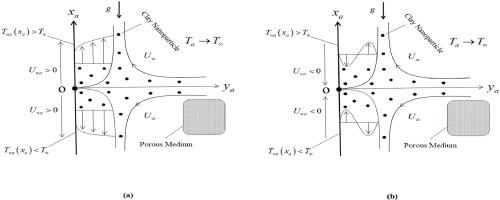粘土纳米颗粒的辐射流动对威廉姆森钻井液在达西-布林克曼多孔介质中穿过垂直表面的润滑性能的影响
IF 4.6
2区 物理与天体物理
Q1 PHYSICS, MULTIDISCIPLINARY
引用次数: 0
摘要
钻井液对于从岩石和土壤中提取气体和石油至关重要。要提高钻井液的效率,纳米粘土颗粒至关重要。在钻井液中使用粘土颗粒可以提高钻井液的导热性、粘度和沸点,从而提高钻井液的耐高温能力,控制钻井液成本。因此,本研究探讨了威廉姆森纳米流体与热源/散热器之间的对流、辐射流动和热传递。使用 Maxwell-Garnett 和 Brinkman 公式定量表示粘土纳米流体的有效热物理性质。预先确定了控制流动现象的物理边界条件的主要 PDEs。使用相似法将这些 PDE 转换为 ODE,然后使用有效的 bvp4c 求解器找到对偶解。对混合对流、渗透性、威廉姆森约束、热源/散热、纳米粒子体积分数和辐射参数的影响都进行了深入的定量和理论研究。计算并以表格和图形形式显示了努塞尔特数和表皮摩擦以及速度和温度曲线。在可收缩片流和浮力辅助流中观察到多种解决方案。研究结果表明,当体积浓度增加时,努塞尔特数明显上升。此外,在下层解决方案中,渗透性参数扩大了边界层厚度,而在上层解决方案中则观察到相反的行为。本文章由计算机程序翻译,如有差异,请以英文原文为准。

Radiative flow of clay nanoparticles on the lubricity of Williamson drilling fluids across a vertical surface in a Darcy-Brinkman porous medium
Drilling fluids are essential for extracting gases and oils from rocks and soil. To increase drilling fluid efficiency, clay nanoparticles are crucial. The use of clay particles in drilling fluids increases their thermal conductivity, viscosity, and boiling point, hence giving resilience to high temperatures and controlling fluid costs. Therefore, this research examines the convection radiative flow and heat transfer incorporated in the Williamson nanofluid with a heat source/sink. The effective thermophysical properties of clay nanofluid are represented quantitatively by using Maxwell-Garnett and Brinkman's formulas. The leading PDEs with physical boundary conditions that control the flow phenomena are predetermined. These PDEs are converted into ODEs using the similarity method, and dual solutions are then found by using an effective bvp4c solver. The effects of mixed convective, permeability, Williamson constraint, heat source/sink, nanoparticle volume fraction, and radiation parameters were all thoroughly studied quantitatively and theoretically. The Nusselt number and skin friction are calculated and displayed in tabular form as well as graphical form along with the velocity and temperature profiles. Multiple solutions are observed in the shrinkable sheet as well as the buoyancy assisting flow. The findings demonstrate that the Nusselt number rises noticeably when volume concentration increases. In addition, the permeability parameter expands the boundary layer thickness in the lower solution, while the contrary behavior is observed in the upper solution.
求助全文
通过发布文献求助,成功后即可免费获取论文全文。
去求助
来源期刊

Chinese Journal of Physics
物理-物理:综合
CiteScore
8.50
自引率
10.00%
发文量
361
审稿时长
44 days
期刊介绍:
The Chinese Journal of Physics publishes important advances in various branches in physics, including statistical and biophysical physics, condensed matter physics, atomic/molecular physics, optics, particle physics and nuclear physics.
The editors welcome manuscripts on:
-General Physics: Statistical and Quantum Mechanics, etc.-
Gravitation and Astrophysics-
Elementary Particles and Fields-
Nuclear Physics-
Atomic, Molecular, and Optical Physics-
Quantum Information and Quantum Computation-
Fluid Dynamics, Nonlinear Dynamics, Chaos, and Complex Networks-
Plasma and Beam Physics-
Condensed Matter: Structure, etc.-
Condensed Matter: Electronic Properties, etc.-
Polymer, Soft Matter, Biological, and Interdisciplinary Physics.
CJP publishes regular research papers, feature articles and review papers.
 求助内容:
求助内容: 应助结果提醒方式:
应助结果提醒方式:


